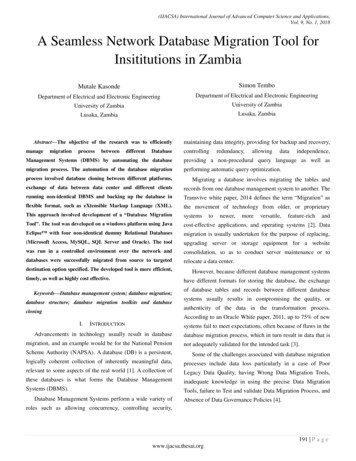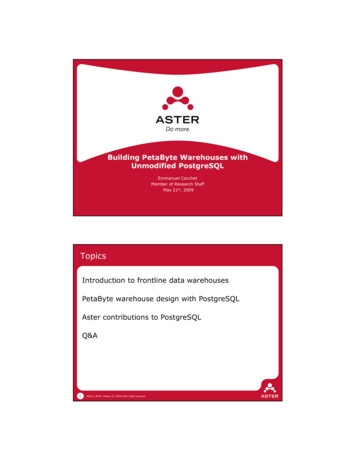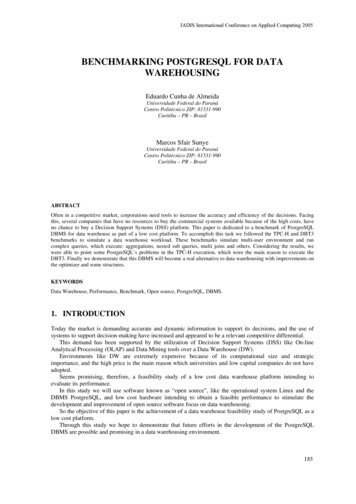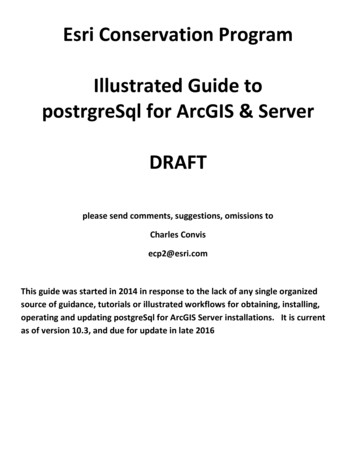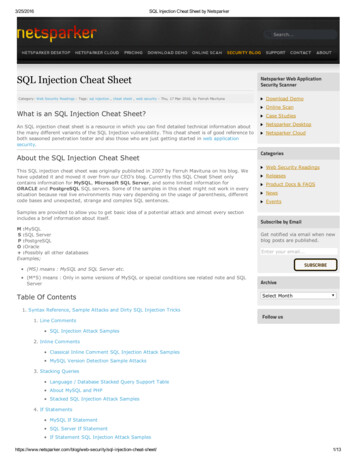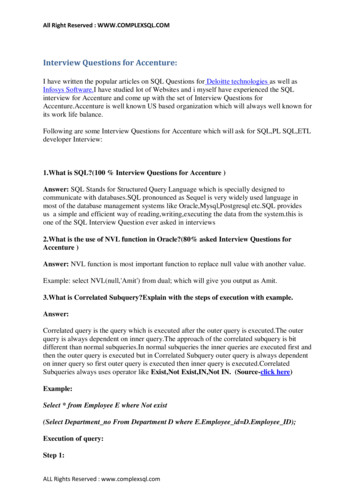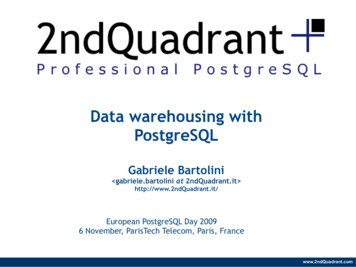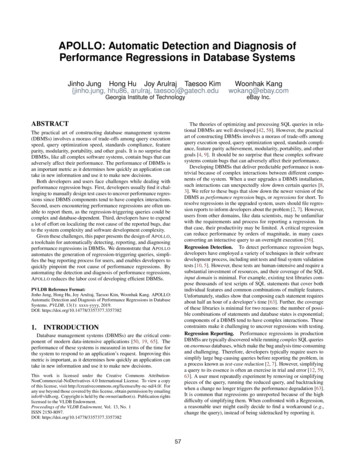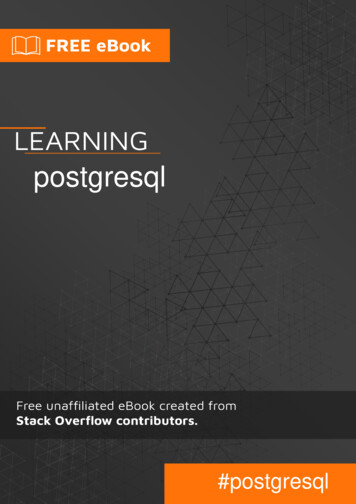
Transcription
postgresql#postgresql
Table of ContentsAbout1Chapter 1: Getting started with postgresql2Remarks2Versions2Examples2Installation on GNU Linux2Red Hat family2Debian family3How to install PostgreSQL via MacPorts on OSX3Postgres.app for Mac OSX5Installing PostgreSQL on Windows5Install postgresql with brew on Mac7Install PostgreSQL from Source on Linux8Chapter 2: Accessing Data ProgrammaticallyExamples1010Accessing Postgresql from .NET using the Npgsql provider10Accessing PostgreSQL with the C-API11Compilation and linking11Sample program11Accessing PostgreSQL from python using psycopg214Accessing PostgreSQL from PHP using Pomm214Chapter 3: Aggregate FunctionsExamples1616Simple statistics: min(), max(), avg()16string agg(expression, delimiter)16regr slope(Y, X) : slope of the least-squares-fit linear equation determined by the (X, Y)17Chapter 4: Backup and Restore19Remarks19Backing up the filesystem instead of using pg dumpall and pg dump19Examples19
Backing up one database19Restoring backups19Backing up the whole cluster20Using Copy to import20To Copy Data from a CSV file to a table20To Copy data from pipe separated file to table20To ignore header line while importing file21Using Copy to export21To Copy table to standard o/p21To Copy table to file21To Copy the output of SQL statement to file21To Copy into a compressed file21Using psql to export dataChapter 5: Backup script for a production rodDb.shChapter 6: COALESCE2425Introduction25Examples25Single non null argument25Multiple non null arguments25All null arguments25Chapter 7: Comments in s26COMMENT on Table26
Remove CommentChapter 8: Common Table Expressions (WITH)Examples262727Common Table Expressions in SELECT Queries27Traversing tree using WITH RECURSIVE27Chapter 9: Connect to PostgreSQL from Java29Introduction29Remarks29Examples30Connecting with java.sql.DriverManager30Connecting with java.sql.DriverManager and Properties30Connecting with javax.sql.DataSource using a connection pool31Chapter 10: Data Types33Introduction33Examples33Numeric Types33Date/ Time Types34Geometric Types35Network Adress Types35Character Types35Arrays35Declaring an Array35Creating an Array36Accessing an Array36Getting information about an array36Array functions37Chapter 11: Dates, Timestamps, and IntervalsExamples3838Cast a timestamp or interval to a string38SELECT the last day of month38Count the number of records per week38Chapter 12: Event Triggers39
Introduction39Remarks39Examples39Logging DDL Command Start EventsChapter 13: Export PostgreSQL database table header and data to CSV file3940Introduction40Examples40Export PostgreSQL table to csv with header for some column(s)40Full table backup to csv with header40copy from query40Chapter 14: EXTENSION dblink and postgres fdw41Syntax41Examples41Extention dblink41Extention FDW41Foreign Data Wrapper42Chapter 15: Find String Length / Character Length44Introduction44Examples44Example to get length of a character varying fieldChapter 16: Inheritance4445Remarks45Examples45Creating children tables45users45simple users45users with password45Altering tables46Adding columns46simple users46Dropping columns46
users46simple users47Chapter 17: INSERTExamples4848Basic INSERT48Inserting multiple rows48Insert from select48Insert data using COPY48INSERT data and RETURING values49SELECT data into file.50UPSERT - INSERT . ON CONFLICT DO UPDATE.50Chapter 18: JSON Support52Introduction52Examples52Creating a pure JSON table52Querying complex JSON documents52Performance of @ compared to - and - 53Using JSONb operators53Creating a DB and a Table53Populating the DB54- operator returns values out of JSON columns54- vs - 55Return NESTED objects55Filtering55Nested filtering56A real world example56JSON operators PostgreSQL aggregate functions57Chapter 19: Postgres cryptographic functions59Introduction59Examples59digest59
Chapter 20: Postgres Tip and TricksExamples6060DATEADD alternative in Postgres60Comma seperated values of a column60Delete duplicate records from postgres table60Update query with join between two tables alternative since Postresql does not support joi60Difference between two date timestamps month wise and year wise60Query to Copy/Move/Transafer table data from one database to other database table with sam61Chapter 21: PostgreSQL High AvailabilityExamplesReplication in PostgreSQLChapter 22: Programming with PL/pgSQL62626265Remarks65Examples65Basic PL/pgSQL Function65PL/pgSQL Syntax66RETURNS Block66custom exceptions66Chapter 23: Recursive queries68Introduction68Examples68Sum of IntegersChapter 24: Role Management6869Syntax69Examples69Create a user with a password69Create Role and matching database69Grant and Revoke Privileges.70Alter default search path of user70Grant access privileges on objects created in the future.71Create Read Only User72Chapter 25: SELECT73
Examples73SELECT using WHERE73Chapter 26: Table Creation74Examples74Table creation with Primary Key74Show table definition74Create table from select74Create unlogged table75Create a table that references other table.75Chapter 27: Triggers and Trigger Functions76Introduction76Remarks76Examples76Basic PL/pgSQL Trigger Function76Type of triggers77Trigger can be specified to fire:77Trigger that is marked:77Preparing to execute examples77Single insert trigger77Step 1: create your function77Step 2: create your trigger78Step 3: test it78Trigger for multiple purpose78Step 1: create your function78Step 2: create your trigger79Step 3: test it79Chapter 28: UPDATEExamples8080Update all rows in a table80Update all rows meeting a condition80Updating multiple columns in table80
Updating a table based on joining another tableChapter 29: Window FunctionsExamples808181generic example81column values vs dense rank vs rank vs row number82Credits83
AboutYou can share this PDF with anyone you feel could benefit from it, downloaded the latest versionfrom: postgresqlIt is an unofficial and free postgresql ebook created for educational purposes. All the content isextracted from Stack Overflow Documentation, which is written by many hardworking individuals atStack Overflow. It is neither affiliated with Stack Overflow nor official postgresql.The content is released under Creative Commons BY-SA, and the list of contributors to eachchapter are provided in the credits section at the end of this book. Images may be copyright oftheir respective owners unless otherwise specified. All trademarks and registered trademarks arethe property of their respective company owners.Use the content presented in this book at your own risk; it is not guaranteed to be correct noraccurate, please send your feedback and corrections to info@zzzprojects.comhttps://riptutorial.com/1
Chapter 1: Getting started with postgresqlRemarksThis section provides an overview of what postgresql is, and why a developer might want to use it.It should also mention any large subjects within postgresql, and link out to the related topics. Sincethe Documentation for postgresql is new, you may need to create initial versions of those relatedtopics.VersionsVersionRelease dateEOL allation on GNU LinuxOn most GNU Linux operating systems, PostgreSQL can easily be installed using the operatingsystem package manager.Red Hat familyRespositories can be found here: d the repository to local machine with the commandyum -y install redhat/rhel-7-x86 l.com/2
View available packages:yum list available grep postgres*Neccesary packages are: postgresqlXX postgresqlXX-server postgresqlXX-libs postgresqlXXcontribThese are installed with the following command: yum -y install postgresqlXX postgresqlXX-serverpostgresqlXX-libs postgresqlXX-contribOnce installed you will need to start the database service as the service owner (Default ispostgres). This is done with the pg ctl command.sudo -su postgres./usr/pgsql-X.X/bin/pg ctl -D /var/lib/pgsql/X.X/data startTo access the DB in CLI enter psqlDebian familyOn Debian and derived operating systems, type:sudo apt-get install postgresqlThis will install the PostgreSQL server package, at the default version offered by the operatingsystem's package repositories.If the version that's installed by default is not the one that you want, you can use the packagemanager to search for specific versions which may simultaneously be offered.You can also use the Yum repository provided by the PostgreSQL project (known as PGDG) toget a different version. This may allow versions not yet offered by operating system packagerepositories.How to install PostgreSQL via MacPorts on OSXIn order to install PostgreSQL on OSX, you need to know which versions are currently supported.Use this command to see what versions you have available.sudo port list grep " postgresql[[:digit:]]\{2\}[[:space:]]"You should get a list that looks something like the ql81databases/postgresql82databases/postgresql833
esql95databases/postgresql96In this example, the most recent version of PostgreSQL that is supported in 9.6, so we will installthat.sudo port install postgresql96-server postgresql96You will see an installation log like this:--- Computing dependencies for postgresql96-server--- Dependencies to be installed: postgresql96--- Fetching archive for postgresql96--- Attempting to fetch postgresql96-9.6beta2 0.darwin 15.x86 64.tbz2 fromhttps://packages.macports.org/postgresql96--- Attempting to fetch postgresql96-9.6beta2 0.darwin 15.x86 64.tbz2.rmd160 fromhttps://packages.macports.org/postgresql96--- Installing postgresql96 @9.6beta2 0--- Activating postgresql96 @9.6beta2 0To use the postgresql server, install the postgresql96-server port--- Cleaning postgresql96--- Fetching archive for postgresql96-server--- Attempting to fetch postgresql96-server-9.6beta2 0.darwin 15.x86 64.tbz2 ver--- Attempting to fetch postgresql96-server-9.6beta2 0.darwin 15.x86 64.tbz2.rmd160 ver--- Installing postgresql96-server @9.6beta2 0--- Activating postgresql96-server @9.6beta2 0To create a database instance, after install dosudo mkdir -p /opt/local/var/db/postgresql96/defaultdbsudo chown postgres:postgres /opt/local/var/db/postgresql96/defaultdbsudo su postgres -c '/opt/local/lib/postgresql96/bin/initdb -D/opt/local/var/db/postgresql96/defaultdb'--- --- --- --- --- --- Cleaning postgresql96-serverComputing dependencies for postgresql96Cleaning postgresql96Updating database of binariesScanning binaries for linking errorsNo broken files found.The log provides instructions on the rest of the steps for installation, so we do that next.sudo mkdir -p /opt/local/var/db/postgresql96/defaultdbsudo chown postgres:postgres /opt/local/var/db/postgresql96/defaultdbsudo su postgres -c '/opt/local/lib/postgresql96/bin/initdb /riptutorial.com/4
Now we start the server:sudo port load -w postgresql96-serverVerify that we can connect to the server:su postgres -c psqlYou will see a prompt from postgres:psql (9.6.1)Type "help" for help.postgres #Here you can type a query to see that the server is running.postgres #SELECT setting FROM pg settings WHERE name 'data directory';And see the -------/opt/local/var/db/postgresql96/defaultdb(1 row)postgres #Type \q to quit:postgres #\qAnd you will be back at your shell prompt.Congratulations! You now have a running PostgreSQL instance on OS/X.Postgres.app for Mac OSXAn extremely simple tool for installing PostgreSQL on a Mac is available by downloadingPostgres.app.You can change preferences to have PostgreSQL run in the background or only when theapplication is running.Installing PostgreSQL on WindowsWhile it's good practice to use a Unix based operating system (ex. Linux or BSD) as a productionserver you can easily install PostgreSQL on Windows (hopefully only as a development server).Download the Windows installation binaries from services-training/pgdownload This is a third-party companyhttps://riptutorial.com/5
started by core contributors to the PostgreSQL project who have optimized the binaries forWindows.Select the latest stable (non-Beta) version (9.5.3 at the time of writing). You will most likely wantthe Win x86-64 package, but if you are running a 32 bit version of Windows, which is common onolder computers, select Win x86-32 instead.Note: Switching between Beta and Stable versions will involve complex tasks like dump andrestore. Upgrading within beta or stable version only needs a service restart.You can check if your version of Windows is 32 or 64 bit by going to Control Panel - System andSecurity - System - System type, which will say "##-bit Operating System". This is the path forWindows 7, it may be slightly different on other versions of Windows.In the installer select the packages you would like to use. For example: pgAdmin ( https://www.pgadmin.org ) is a free GUI for managing your database and I highlyrecommend it. In 9.6 this will be installed by default . PostGIS ( http://postgis.net ) provides geospatial analysis features on GPS coordinates,distances etc. very popular among GIS developers. The Language Package provides required libraries for officially supported procedurallanguage PL/Python, PL/Perl and PL/Tcl. Other packages like pgAgent, pgBouncer and Slony are useful for larger production servers,only checked as needed.All those optional packages can be later installed through "Application Stack Builder".Note: There are also other non-officially supported language such as PL/V8, PL/Lua PL/Javaavailable.Open pgAdmin and connect to your server by double clicking on its name, ex. "PostgreSQL 9.5(localhost:5432).From this point you can follow guides such as the excellent book PostgreSQL: Up and Running,2nd Edition ( http://shop.oreilly.com/product/0636920032144.do ).Optional: Manual Service Startup TypePostgreSQL runs as a service in the background which is slightly different than most programs.This is common for databases and web servers. Its default Startup Type is Automatic whichmeans it will always run without any input from you.Why would you want to manually control the PostgreSQL service? If you're using your PC as adevelopment server some of the time and but also use it to play video games for example,PostegreSQL could slow down your system a bit while its running.Why wouldn't you want manual control? Starting and stopping the service can be a hassle if youdo it often.If you don't notice any difference in speed and prefer avoiding the hassle then leave its Startuphttps://riptutorial.com/6
Type as Automatic and ignore the rest of this guide. Otherwise.Go to Control Panel - System and Security - Administrative Tools.Select "Services" from the list, right click on its icon, and select Send To - Desktop to create adesktop icon for more convenient access.Close the Administrative Tools window then launch Services from the desktop icon you justcreated.Scroll down until you see a service with a name like postgresql-x##-9.# (ex. "postgresql-x64-9.5").Right click on the postgres service, select Properties - Startup type - Manual - Apply - OK.You can change it back to automatic just as easily.If you see other PostgreSQL related services in the list such "pgbouncer" or "PostgreSQLScheduling Agent - pgAgent" you can also change their Startup Type to Manual because they'renot much use if PostgreSQL isn't running. Although this will mean more hassle each time you startand stop so it's up to you. They don't use as many resources as PostgreSQL itself and may nothave any noticeable impact on your systems performance.If the service is running its Status will say Started, otherwise it isn't running.To start it right click and select Start. A loading prompt will be displayed and should disappear onits own soon after. If it gives you an error try a second time. If that doesn't work then there wassome problem with the installation, possibly because you changed some setting in Windows mostpeople don't change, so finding the problem might require some sleuthing.To stop postgres right click on the service and select Stop.If you ever get an error while attempting to connect to your database check Services to make sureits running.For other very specific details about the EDB PostgreSQL installation, e.g. the python runtimeversion in the official language pack of a specific PostgreSQL version, always refer to the officialEBD installation guide , change the version in link to your installer's major version.Install postgresql with brew on MacHomebrew calls itself 'the missing package manager for macOS'. It can be used to build andinstall applications and libraries. Once installed, you can use the brew command to installPostgreSQL and it's dependencies as follows:brew updatebrew install postgresqlHomebrew generally installs the latest stable version. If you need a different one then brew searchpostgresql will list the versions available. If you need PostgreSQL built with particular options thenbrew info postgresql will list which options are supported. If you require an unsupported buildhttps://riptutorial.com/7
option, you may have to do the build yourself, but can still use Homebrew to install the commondependencies.Start the server:brew services start postgresqlOpen the PostgreSQL promptpsqlIf psql complains that there's no corresponding database for your user, run createdb.Install PostgreSQL from Source on LinuxDependencies: GNU Make Version 3.80an ISO/ ANSI C-Compiler (e.g. gcc)an extractor like tar or gzipzlib-develreadline-devel oder libedit-develSources: Link to the latest source (9.6.3)Now you can extract the source files:tar -xzvf postgresql-9.6.3.tar.gzThere are a large number of different options for the configuration of PostgreSQL:Full Link to the full installation procedureSmall list of available options: path for all files--exec-prefix PATH path for architectur-dependet file--bindir PATH path for executable programs--sysconfdir PATH path for configuration files--with-pgport NUMBER specify a port for your server--with-perl add perl support--with-python add python support--with-openssl add openssl support--with-ldap add ldap support--with-blocksize BLOCKSIZE set pagesize in KBBLOCKSIZE must a power of 2 and between 1 and 32 --with-wal-segsize SEGSIZE set size of WAL-Segment size in MBSEGSIZE must be a power of 2 between 1 and 64--prefix PATH https://riptutorial.com/8
Go into the new created folder and run the cofigure script with the desired options:./configure --exec /usr/local/pgsqlRun make to create the objectfilesRun makeinstallRun makecleanto install PostgreSQL from the built filesto tidy upFor the extension switch the directory cdcontrib,run make and makeinstallRead Getting started with postgresql online: ngstarted-with-postgresqlhttps://riptutorial.com/9
Chapter 2: Accessing Data ProgrammaticallyExamplesAccessing Postgresql from .NET using the Npgsql providerOne of the more popular .NET providers for Postgresql is Npgsql, which is ADO.NET compatibleand is used nearly identically as other .NET database providers.A typical query is performed by creating a command, binding parameters, and then executing thecommand. In C#:var connString "Host myserv;Username myuser;Password mypass;Database mydb";using (var conn new NpgsqlConnection(connString)){var querystring "INSERT INTO data (some field) VALUES (@content)";conn.Open();// Create a new command with CommandText and Connection constructorusing (var cmd new NpgsqlCommand(querystring, conn)){// Add a parameter and set its type with the NpgsqlDbType enumvar contentString "Hello World!";cmd.Parameters.Add("@content", NpgsqlDbType.Text).Value contentString;// Execute a query that returns no resultscmd.ExecuteNonQuery();/* It is possible to reuse a command object and open connection instead of creatingnew ones */// Create a new query and set its parametersint keyId 101;cmd.CommandText "SELECT primary key, some field FROM data WHERE primary key "@keyId", NpgsqlDbType.Integer).Value keyId;// Execute the command and read through the rows one by oneusing (NpgsqlDataReader reader cmd.ExecuteReader()){while (reader.Read())// Returns false for 0 rows, or after reading the last rowof the results{// read an integer valueint primaryKey reader.GetInt32(0);// orprimaryKey Convert.ToInt32(reader["primary key"]);// read a text valuestring someFieldText reader["some field"].ToString();}}}https://riptutorial.com/10
}// the C# 'using' directive calls conn.Close() and conn.Dispose() for usAccessing PostgreSQL with the C-APIThe C-API is the most powerful way to access PostgreSQL and it is surprisingly comfortable.Compilation and linkingDuring compilation, you have to add the PostgreSQL include directory, which can be found withpg config --includedir, to the include path.You must link with the PostgreSQL client shared library (libpq.so on UNIX, libpq.dll onWindows). This library is in the PostgreSQL library directory, which can be found with pg config -libdir.Note: For historical reason, the library is called libpq.soand not libpg.so, which is a popular trapfor beginners.Given that the below code sample is in file coltype.c, compilation and linking would be done withgcc -Wall -I " (pg config --includedir)" -L " (pg config --libdir)" -o coltype coltype.c -lpqwith the GNU C compiler (consider adding -Wl,-rpath," (pg configsearch path) or with--libdir)"to add the librarycl /MT /W4 /I include directory coltype.c path to libpq.lib on Windows with Microsoft Visual C.Sample program/* necessary for all PostgreSQL client programs, should be first */#include libpq-fe.h #include stdio.h #include string.h #ifdef TRACE#define TRACEFILE "trace.out"#endifint main(int argc, char **argv) {#ifdef TRACEFILE *trc;#endifPGconn *conn;PGresult *res;int rowcount, colcount, i, j, firstcol;/* parameter type should be guessed by PostgreSQL */const Oid paramTypes[1] { 0 };https://riptutorial.com/11
/* parameter value */const char * const paramValues[1] { "pg database" };/** Using an empty connectstring will use default values for everything.* If set, the environment variables PGHOST, PGDATABASE, PGPORT and* PGUSER will be used.*/conn PQconnectdb("");/** This can only happen if there is not enough memory* to allocate the PGconn structure.*/if (conn NULL){fprintf(stderr, "Out of memory connecting to PostgreSQL.\n");return 1;}/* check if the connection attempt worked */if (PQstatus(conn) ! CONNECTION OK){fprintf(stderr, "%s\n", PQerrorMessage(conn));/** Even if the connection failed, the PGconn structure has been* allocated and must be freed.*/PQfinish(conn);return 1;}#ifdef TRACEif (NULL (trc fopen(TRACEFILE, "w"))){fprintf(stderr, "Error opening trace file \"%s\"!\n", TRACEFILE);PQfinish(conn);return 1;}/* tracing for client-server communication */PQtrace(conn, trc);#endif/* this program expects the database to return data in UTF-8 */PQsetClientEncoding(conn, "UTF8");/* perform a query with parameters */res PQexecParams(conn,"SELECT column name, data type ""FROM information schema.columns ""WHERE table name 1",1,/* one parameter */paramTypes,paramValues,NULL,/* parameter lengths are not required for strings */NULL,/* all parameters are in text format */0/* result shall be in text format */);https://riptutorial.com/12
/* out of memory or sever communication broken */if (NULL res){fprintf(stderr, "%s\n", PQerrorMessage(conn));PQfinish(conn);#ifdef TRACEfclose(trc);#endifreturn 1;}/* SQL statement should return results */if (PGRES TUPLES OK ! PQresultStatus(res)){fprintf(stderr, "%s\n", PQerrorMessage(conn));PQfinish(conn);#ifdef TRACEfclose(trc);#endifreturn 1;}/* get count of result rows and columns */rowcount PQntuples(res);colcount PQnfields(res);/* print column headings */firstcol 1;printf("Description of the table \"pg database\"\n");for (j 0; j colcount; j){if (firstcol)firstcol 0;elseprintf(": ");printf(PQfname(res, j));}printf("\n\n");/* loop through rosult rows */for (i 0; i rowcount; i){/* print all column data */firstcol 1;for (j 0; j colcount; j){if (firstcol)firstcol 0;elseprintf(": ");printf(PQgetvalue(res, i, j));}printf("\n");}https://riptutorial.com/13
/* this must be done after every statement to avoid memory leaks */PQclear(res);/* close the database connection and release memory */PQfinish(conn);#ifdef TRACEfclose(trc);#endifreturn 0;}Accessing PostgreSQL from python using psycopg2You can find description of the driver here.The quick example is:import psycopg2db hostdb portdb un db pw db name 'postgres.server.com' '5432''user''password' 'testdb'conn psycopg2.connect("dbname {} host {} user {} password {}".format(db name, db host, db un, db pw),cursor factory RealDictCursor)cur conn.cursor()sql 'select * from testtable where id %s and id %s'args (1, 4)cur.execute(sql, args)print(cur.fetchall())Will result:[{'id': 2, 'fruit': 'apple'}, {'id': 3, 'fruit': 'orange'}]Accessing PostgreSQL from PHP using Pomm2On the shoulders of the low level drivers, there is pomm. It proposes a modular approach, dataconverters, listen/notify support, database inspector and much more.Assuming, Pomm has been installed using composer, here is a complete example: ?phpuse PommProject\Foundation\Pomm; loader require DIR . '/vendor/autoload.php'; pomm new Pomm(['my db' ['dsn' 'pgsql://user:pass@host:5432/db name']]);// TABLE comment (// comment id uuid PK, created at timestamptz NN,// is moderated bool NN default false,https://riptutorial.com/14
// content text NN CHECK (content ! ' \s '), author email text NN) sql SQLSELECTcomment id,created at,is moderated,content,author emailFROM commentINNER JOIN author USING (author email)WHEREage(now(), created at) *::intervalORDER BY created at ASCSQL;// the argument will be converted as it is cast in the query above comments pomm['my db']- getQueryManager()- query( sql, [DateInterval::createFromDateString('1 day')]);if ( comments- isEmpty()) {printf("There are no new comments since yesterday.");} else {foreach ( comments as comment) {printf("%s has posted at %s. %s\n", comment['author email'], comment['created at']- format("Y-m-d H:i:s"), comment['is moderated'] ? '[OK]' : '');}}Pomm’s query manager module escapes query arguments to prevent SQL injection. When thearguments are cast, it also converts them from a PHP representation to valid Postgres values. Theresult is an iterator, it uses a cursor internally. Every row is converted on the fly, booleans tobooleans, timestamps to \DateTime etc.Read Accessing Data Programmatically ial.com/15
Chapter 3: Aggregate FunctionsExamplesSimple statistics: min(), max(), avg()In order to determine some simple statistics of a value in a column of a table, you can use anaggregate function.If your individuals table is:NameAgeAllie17Amanda14Alana20You could write this statement to get the minimum, maximum and average value:SELECT min(age), max(age), avg(age)FROM individuals;Result:minmaxavg142017string agg(expression, delimiter)You can concatenate strings separated by delimiter using the string agg() function.If your individuals table aYou could write SELECThttps://riptutorial.com/. GROUP BYstatement to get names from each country:16
SELECT string agg(name, ', ') AS names, countryFROM individualsGROUP BY country;Note that you need to use a GROUPBYclause because string agg() is an aggregate function.Result:namescountryAllie, AmandaUSAAlanaRussiaMore PostgreSQL aggregate function described hereregr slope(Y, X) : slope of the least-squares-fit linear equation determined bythe (X, Y) pairsTo illustrate how to use regr slope(Y,X), I applied it to a real world problem. In Java, if you don'tclean up memory properly, the garbage can get stuck and fill up the memory. You dump statisticsevery hour about memory utilization of different classes and load it into a postgres database foranalysis.All memory leak candidates will have a trend of consuming more memory as more time passes. Ifyou plot this trend, you would imagine a line going up and to the left:size(bytes) Legend: * - data point -- - trend * - - * -* - *-* -* -- *--------------------------------------- timeSuppose you have a table containing heap dump histogram data (a mapping of classes to howmuch memory they consume):CREATE TABLE heap histogram (-- when the heap histogram was takenhistwhen timestamp without time zone NOT NULL,-- the object type bytes are referring tohttps://riptutorial.com/17
-- ex: java.util.Stringclass character varying NOT NULL,-- the size in bytes used by the above classbytes integer NOT NULL);To compute the slope for each class, we group by over the class. Th
Connecting with java.sql.DriverManager 30 Connecting with java.sql.DriverManager and Properties 30 Connecting with javax.sql.DataSource using a connection pool 31 Chapter 10: Data Types 33 Introduction 33 Examples 33 Numeric Types 33 Date/ Time Types 34 Geometric Types 35 Network Adress Ty


